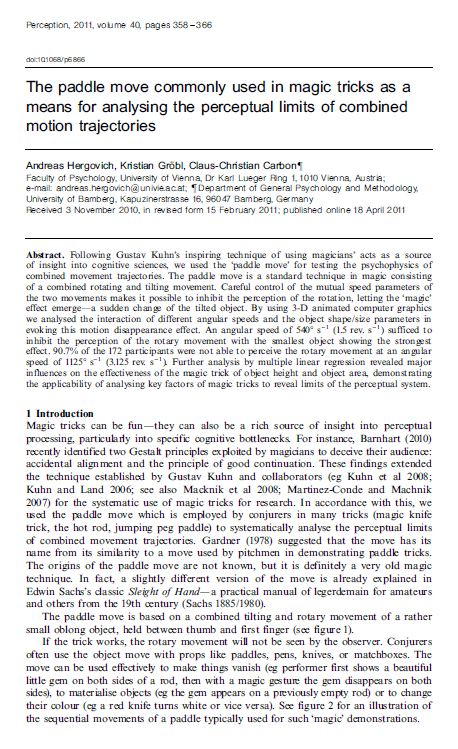

People’s Magic Library
Eight centuries of open access books about magic.
4519 documents to read and/or download.
Support the Library
Finding and recording new books to let the give you a free-of-charge access to this treasure requires a huge commitment. If you want to support this project, consider the idea of making a donation using this button:
 |  | 7-16 of 26 documents in category “Psychology”
|  |  |
 | Enrico MORSELLI Psicologia e spiritismo. Impressioni e note critiche sui fenomeni medianici di Eusapia Paladino Vol. 2, Fratelli Bocca, Torino 1908. |
|
 | Montague SUMMERS The Physical Phenomena of Mysticism Barnes & Noble, New York 1950. |
|
 | Raphael SETH TAYLOR The Wonder of Magic: Eliciting Wonder and Analyzing its Expression Hampshire College, 2004. |
|
 | Mireille BERTON Alfred Binet entre illusionnisme, spiritisme et cinéma des origines Recherches & Educations, Vol. 1, 2008, pp. 197-201. |
|
 | Andreas HERGOVICH, Kristian GRUBL e Claus-Christian CARBON The paddle move commonly used in magic tricks as a means for analysing the perceptual limits of combined motion trajectories Perception, N. 3, Vol. 40, march 2011, pp. 358-266.Following Gustav Kuhn's inspiring technique of using magicians' acts as a source of insight into cognitive sciences, the authors used the "paddle move" for testing the psychophysics of combined movement trajectories. The paddle move is a standard technique in magic consisting of a combined rotating and tilting movement. Careful control of the mutual speed parameters of the two movements makes it possible to inhibit the perception of the rotation, letting the "magic" effect emerge-a sudden change of the tilted object. By using 3-D animated computer graphics we analysed the interaction of different angular speeds and the object shape/size parameters in evoking this motion disappearance effect. An angular speed of 540° per second sufficed to inhibit the perception of the rotary movement with the smallest object showing the strongest effect. 90.7% of the 172 participants were not able to perceive the rotary movement at an angular speed of 1125 ° per second. Further analysis by multiple linear regression revealed major influences on the effectiveness of the magic trick of object height and object area, demonstrating the applicability of analysing key factors of magic tricks to reveal limits of the perceptual system. |
|
 | Gustav KUHN, Hugo A. CAFFARATTI, Robert TESZKA e Ronald A. RENSINK A psychologically-based taxonomy of misdirection Frontiers in Psychology, Vol. 5, 2014, p. 1392.One of the 14 articles in the series The Psychology of Magic and the Magic of Psychology published on Frontiers in Psychology between 2014 and 2015. |
|
 | Anthony S. BARNHART e Stephen D. GOLDINGER Blinded by magic: eye-movements reveal the misdirection of attention Frontiers in Psychology, Vol. 5, 2014, p. 1461.One of the 14 articles in the series The Psychology of Magic and the Magic of Psychology published on Frontiers in Psychology between 2014 and 2015. |
|
 | Rissanen OLLI, Petteri PITKÄNEN, Antti JUVONEN, Gustav KUHN e Kai HAKKARAINEN Expertise among professional magicians: an interview study Frontiers in Psychology, Vol. 5, 2014, p. 1484.One of the 14 articles in the series The Psychology of Magic and the Magic of Psychology published on Frontiers in Psychology between 2014 and 2015. |
|
 | Howard WILLIAMS e Peter W. MCOWAN Magic in the machine: a computational magician's assistant Frontiers in Psychology, Vol. 5, 2014, p. 1283.One of the 14 articles in the series The Psychology of Magic and the Magic of Psychology published on Frontiers in Psychology between 2014 and 2015. |
|
 | Howard WILLIAMS e Peter W. MCOWAN Magic in the machine: a computational magician's assistant Frontiers in Psychology, Vol. 5, 2014, p. 1283.One of the 14 articles in the series The Psychology of Magic and the Magic of Psychology published on Frontiers in Psychology between 2014 and 2015. |
|
 |  | 7-16 of 26 documents in category “Psychology”
|  |  |













